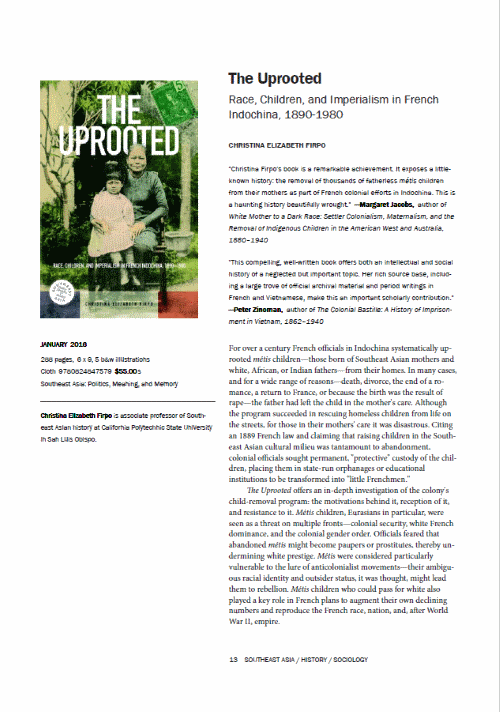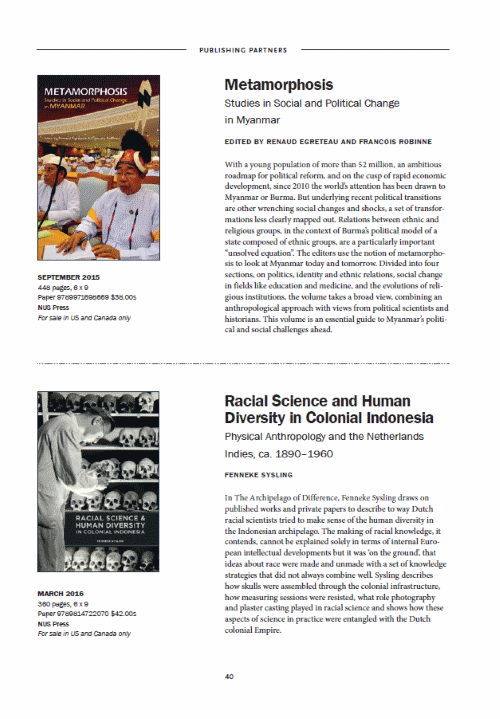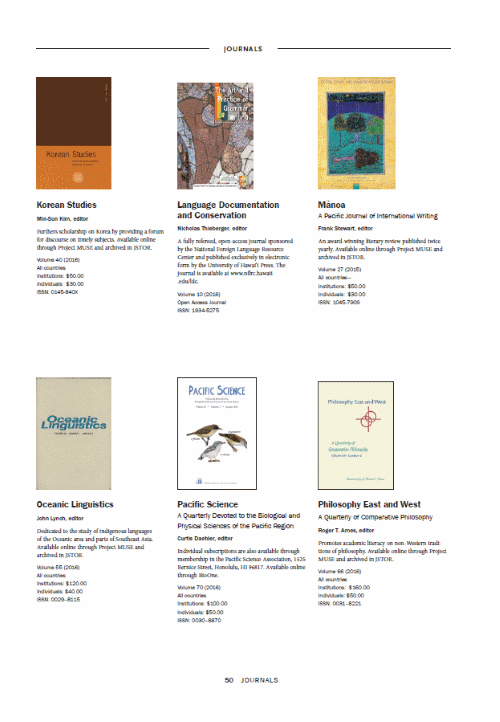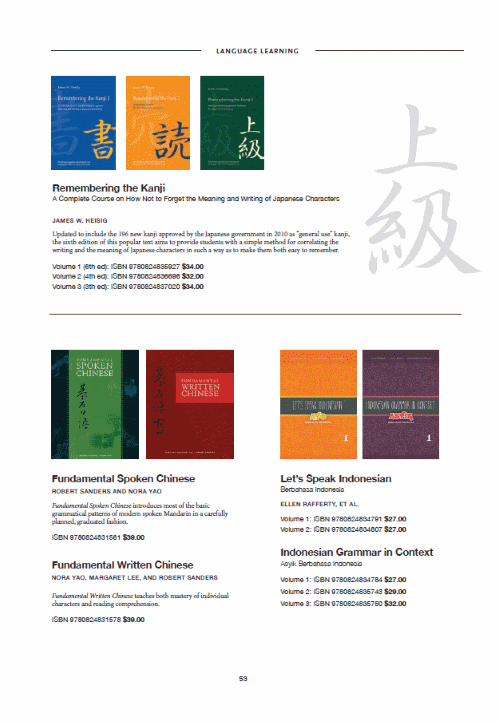Publisher Marketing Catalog Production
14 March 2016
One of the most important tools for publishers with relatively large front and backlist portfolios is their marketing catalogs. Here is how to create them with classic digital publishing techniques.
Publishing Business Tools

University of Hawai‘i Press. Spring Catalog 2016
Publishing is a business that needs marketing and sales tools of all types. One of the most important tools for publishers with relatively large front and backlist portfolios is their marketing catalogs.
The University of Hawai‘i Press (UoH) is very busy and have an agressive print and digital publishing strategy. Because they are in the center of the Pacific they are at the centerpoint of more social, political, cultural and language diversity than any other location on the planet. They are also the most physically remote academic publisher on the planet. They have a strong focus on Asia Pacific cultures and languages and publish across a highly diverse range of subjects. They also have a trade publishing operation.
The UoH catalog of new books is released in the spring and fall each year. In addition to this they need custom catalog editions for tradeshows and conferences around the region and the world.
The catalog content is maintained in a database and in the past that has been exported to InDesign via Word and/or Excel for manual production and completion to the print edition. This was a laborous process that took many weeks of coordinated work.
Stepping up to full digital
The University of Hawai‘i Press use IGP:Digital Publisher for much of their textbook production work and backlist digitization. It has been especially useful for bringing multi-language print-dead books back to life. It is prohibitively expensive to reset these complex multi-language books. There is a number of other digital revival projects on the drawing board.
Trond Knutsen (Digital Publishing Manager UoH) asked if we would be able to automate the catalog production process to some level using IGP:Digital Publisher. He provided a sample catalog and the spreadsheet with the catalog content for review. The Infogrid Pacific Team got busy.
The Solution
Infogrid Pacific is working with academic, trade, education, government and corporate publishers around the world help them redefine their new digital strategies while strengthening their current business strategies.
IGP:Digital Publisher can import styled and structured content from wordprocessor and spreadsheets. There are customizable tools to make this relatively easy to implement. The spreadsheet was analysed for conversion to a suitable semantic catalog HTML using the IGP:FoundationXHTML methods.
Production Project Manager Michael D'Souza decided to design a new set of semantic classes and tagging patterns customized for the University of Hawai'i press. A catalog is not a book and it quickly became apparent that catalogs needed their own approach.
One of the strengths of IGP:Digital Publisher and IGP:FoundationXHTML is that they drop XML production resource overhead and maintenance costs. It's a ground reality that when it comes to multi-format, dynamic digital publishings, XML first adds to the content-cost bill, reduces the content usability into the future and dramatically increases both short and long-term content ownership.

The single book template page

Two book vertical template page (horizontal also available)
The tagging pattern and CSS class semantics for a simple page looks something like this ( Click here for those interested). Of course the real work is done by CSS at content creation time.
There are multiple catalogue page types containing, one, two, six and nine books in flowable column structures. Each book item has exactly the same content in them and CSS properties are used to manipulate the visible content in each catalog item for the page layout it falls on.
This approach ensures the content is highly reusable. The same content can be distributed as an eBook or published to a dynamic or static website where all the content for each book item could be displayed. In addition any catalog item can be used in any page presentation.

Six book template page

Custom layout page using standard template layout blocks
Outcome
The University of Hawaii Spring 2016 Catalog was produced by the University Press team using IGP:Digital Publisher with the new tools and delivered on time.
The time taken to create, edit and produce the catalog was reduced from the usual weeks to just a few days.
We are now looking at building more templates and automation into the system, moving ahead from lessons learned.
After using Digital Publisher for our Spring 2016 seasonal catalog, we can't imagine going back to our old ways ever again. The process used to be needlessly cumbersome in so many ways, especially for something as time sensitive (yet time consuming) and data driven (yet design heavy) as presenting our forthcoming books in a print catalog. We now have a cost-effective and user-friendly way to produce a variety of print and digital marketing materials, nearly instantaneous, and always as accurate as our latest data - and without having to compromise on design. It simply wouldn't have been possible without IGP:Digital Publisher and the stellar team at IGP.
Trond Knutsen, Digital Publishing Manager, University of Hawai‘i Press
Posted by Richard Pipe, Michael D'Souza